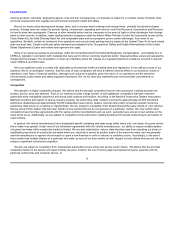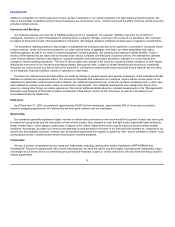AutoNation 2003 Annual Report Download - page 20
Download and view the complete annual report
Please find page 20 of the 2003 AutoNation annual report below. You can navigate through the pages in the report by either clicking on the pages listed below, or by using the keyword search tool below to find specific information within the annual report.
Table of Contents
Overview
AutoNation, Inc. is the largest automotive retailer in the United States. As of December 31, 2003, we owned and operated 367 new
vehicle franchises from 283 dealerships located in major metropolitan markets in 17 states, predominantly in the Sunbelt region of the
United States. Our stores, which we believe include some of the most recognizable and well-known in our key markets, sell 35 different
brands of new vehicles. The core brands of vehicles that we sell, representing approximately 98% of the new vehicles that we sold in 2003,
are manufactured by Ford, General Motors, Daimler Chrysler, Toyota, Nissan, Honda and BMW.
We offer a diversified range of automotive products and services, including new vehicles, used vehicles, vehicle maintenance and repair
services, vehicle parts, extended service contracts, vehicle protection products and other aftermarket products. We also arrange financing for
vehicle purchases through third-party finance sources. We believe that the significant scale of our operations and the quality of our
managerial talent allow us to achieve efficiencies in our key markets by, among other things, reducing operating expenses, leveraging our
market brands and advertising, improving asset management and sharing and implementing best practices across all of our stores.
The automotive retailing industry historically has been subject to substantial cyclical variation characterized by periods of oversupply of
new vehicles and weak consumer demand. We believe that many factors affect industry-wide sales of new vehicles and retailers’ gross profit
margins, including, among other factors, consumer confidence in the economy, the level of manufacturers’ excess production capacity,
manufacturer incentives (and consumers’ reaction to such offers), intense industry competition, interest rates and the level of personal
discretionary spending.
For the years ended December 31, 2003 and 2002, we had net income from continuing operations of $506.1 million and $381.6 million,
respectively, and diluted earnings per share from continuing operations of $1.76 and $1.19, respectively. Our results of operations in 2003
benefited from an Internal Revenue Service (“IRS”) settlement (which resulted in the recognition of an income tax benefit of $127.5 million)
and the leveraging of our cost structure. Additionally, our earnings per share benefited from our repurchase of outstanding shares.
During 2003, we experienced a decrease in new vehicle volume due to lower consumer demand in certain markets in which we operate
and for certain brands sold by us. We experienced downward pressure on our new vehicle gross profit margins during 2003, which we
believe was largely due to manufacturers’ excess production capacity and intense competition in the industry. While we anticipate that the
new vehicle market will remain intensely competitive in 2004 and that manufacturers will look to reduce incentives offered to consumers, we
expect that an improving economic environment will stabilize both new vehicle volumes and margins. However, the level of retail sales and
gross profit for 2004 is very difficult to predict. Also, 2003 benefited from increased finance and insurance revenue and gross profit due to
increased product penetration and lower interest rates. Significantly higher interest rates in 2004 may negatively impact finance and
insurance revenue and gross profit.
The following factors have impacted our financial condition and results of operations in 2003 and may cause our reported financial data
not to be indicative of our future financial condition and operating results:
• Income Taxes: In 2003, we entered into a settlement agreement with the IRS with respect to certain transactions entered into in
1997 and 1999, whereby we agreed to make certain payments to the IRS through March 2007. As a result of the settlement, we
recognized an income tax benefit of $127.5 million from the reduction of previously recorded deferred tax liabilities. In July 2003,
we made a $366 million prepayment of the initial amount due March 2004. Interest expense in 2003 related to the IRS settlement
totaled $12.1 million. See further discussion under the heading “Non-operating Income (Expense) — Income Tax Benefit from IRS
Settlement.” Additionally, in 2003, we recorded net income tax benefits totaling $13.4 million related to favorable adjustments and
the resolution of various income tax matters.
• Share Repurchases: During 2003, we acquired 39.2 million shares of our common stock for an aggregate purchase price of
$575.2 million. As of December 31, 2003, we have Board authoriza-
18
























